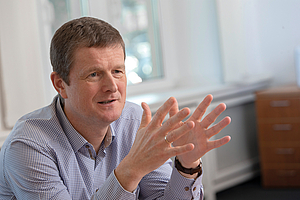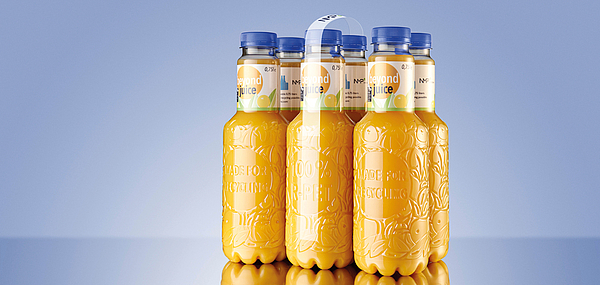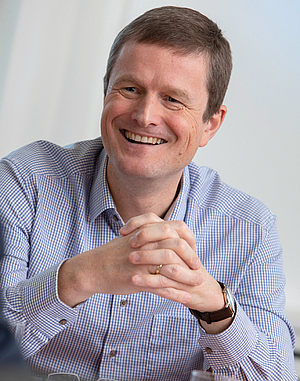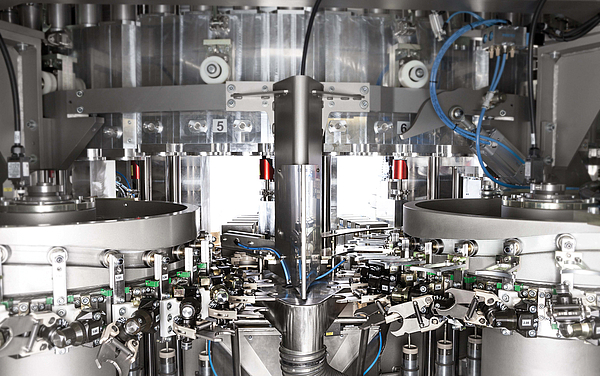

Photo credit: KHS
The future of plastic packaging: Opinion and knowledge
How does KHS view the issue around PET?
Kai Acker, Managing Director of KHS, has put his own stamp on things in the office. The old paintings have given way to images relating to engineering and technology. The room now has a light, airy feel that creates a bright and friendly atmosphere. This leads us swiftly in medias res, the main topic we are here to discuss: Climate, the environment and sustainability.
Acker has been CEO of KHS in Dortmund for just over a year. He lives with his family in Oldenburg and jokes at the beginning of our conversation about his new home town, where his family have settled in quickly after numerous relocations in recent years: By current calculations, he explains, Oldenburg is acutely threatened by rising sea levels. However, the American researchers who came to this conclusion failed to factor the dikes into their calculations so the danger is probably not yet as great as feared.
In the context of climate change and protection, packaging, particularly plastic packaging has received significant attention. This also includes PET bottles. KHS Corpoplast has played a decisive role in advancing PET technology. How do you assess the current situation against the backdrop of 50 years of development work?
Acker: Yes, indeed, the packaging industry, and with it the PET industry, can be seen as part of the problem. But I also see us as part of the solution. Cynics may say “Well, he would say that. He has to protect and develop his business.” Companies naturally pursue goals and are often measured by them. Environmental organisations also pursue goals. But we are not blinkered. We try to identify and address problems. And we are absolutely open and motivated to help overcome them. Moreover, I am convinced that the interests of industry and environmental organisations overlap far more than you might imagine.

Do you think that the level and manner of the debate have been appropriate?
Acker: I welcome the fact that the environment and climate are now in the spotlight. Indeed, I particularly welcome the fact that new initiatives often come from young people. To me, “Fridays for Future”, Greta Thunberg and her fellow campaigners have first and foremost opened our eyes. They have set things in motion. On the other hand, it is also clear that the debate has become very emotional, making it more difficult to convey facts. I wish the debate was more in-depth. I notice it – I’m sure everyone in the industry does – when I have discussions in my family, with my daughter or friends. An in-depth debate is exactly what we need if we are to understand the extent of the problem and find solutions. To comprehend what it all means and all of the consequences. Solutions can then be developed on that basis.
Do you see the key players in the industry as having a duty to respond, possibly via joint initiatives?
Acker: I am sure I am not only speaking for KHS when I say that we would like to see far more objective facts being used, especially in politics. And of course I am happy to do my part. But I have my doubts about whether, as an industry, we can achieve more with joint initiatives. Today, at any rate, with this conversation, I am happy to contribute to wider reflections on the issues based on objective facts.
Is the core problem of the PET industry ensuring that it is perceived by consumers both professionally and emotionally, under the motto “PET is super”?
Acker: As experts, we know and understand the special features of PET, the technological advances, how sustainable it is as a form of packaging. In my view, a kind of disenchantment with technology is spreading through society. Scepticism is growing. People are not sure if we are on the right path. This can be seen in university enrolments, where the numbers of students in technical programmes are dropping. That has a major impact on industry as a whole. We must stop any further erosion in trust in technology. On the contrary: We urgently need to win it back. But this loss of trust is due to more than just the climate debate around plastics. Look at the automobile industry and its diesel scandal. Many of those involved have damaged one thing above all: Consumer trust in diesel technology and engines.
Of course, consumers are also wondering where all the plastic waste comes from.
Acker: Let me give you an example: I enjoy spending time on Amrum island, a holiday island off Germany’s North Sea coast. It has recently brought in a ban on disposable PET. Does that solve any problems? No! I am sure that packaging is not carelessly thrown away on Amrum, polluting the island’s beaches. I personally don’t know anyone at all who simply throws their PET bottles away when they are finished. Germany has a deposit scheme which has a number of advantages. Firstly: Consumers return deposit bottles. They do not end up in nature. Secondly: Consumers can have a clear conscience. They are part of the recycling system and contribute to a clean environment in their own small way. Back to Amrum: Until the ban, deposit bottles were collected on the island too. Looking around, Are there fewer PET bottles in nature now? No! It is a well-known fact that the litter in the oceans flows out of the ten largest rivers in Africa and Asia.
And not because people in these countries just throw their waste into the rivers but because garbage is disposed of on the river banks on a grand scale. I myself lived for a good two years in Jarkata, Indonesia. Garbage pickup? Disposal? Forget it. And if you look at the images and try to imagine all that packaging made of glass instead, for example, you quickly understand that it wouldn’t solve anything.
So the end of the chain is the problem: Could a European consumer find their properly disposed PET bottle in Indonesia, for example?
Acker: Well, they shouldn’t but I think it happens. Personally, I think developed countries should take care of disposing their own waste. We have the necessary technology and extra capacity should be added if necessary. For example, we are no longer allowed to export used PET bottles.
Who actually makes money from the system? Nobody talks about the waste management industry.
Acker: I don’t know enough about it. According to everything that one reads in the media, the situation is very complex. In my opinion, disposing of European waste in Africa or Asia for a profit does not solve anything. Governments have a duty to stop it happening.
Do consumers know too little? And what do the decision-makers, the politicians, know? On what basis are decisions made, like the “ban on disposable bottles on Amrum”?
Acker: (laughs) Sometimes I wonder whether industry is where I should be, or whether I should go into politics. Then again, there’s still work to do in industry. As one of the representatives of this industry, I like to work on facts, ensure that facts are available as a basis for decision making. We do this, on a small scale, with our employees. We inform, train, equip them with facts. They in turn share them with their family and friends. Certainly, we could also advise the political decision-makers. They’d have to be willing, of course, otherwise it’d all be for nothing.
How do you reach the decision-makers?
Acker: Decision-makers have to be willing to see the big picture. Let’s take steel as an example. Just like plastic, steel production suffers from a bad image. The German Green party contacted Salzgitter AG to get more information first hand.
That was very welcome. And something I particularly appreciated: After the visit, one member of the party leadership was still very interested and got back in touch several times, looking for detailed information to really understand the ins and the outs. Without taking sides, that really impressed me. It showed that decision-makers are committed and have the will to understand technology, sustainability and alternatives with all their consequences.

The small island of Amrum - the big rivers in Africa and Asia. The global challenges are complex. Where do you see the technical solutions coming from?
Acker: A major challenge, indeed, a Herculean challenge in my view, is population growth and I don’t think it has been given sufficient attention. Two thousand years ago, it is estimated that the global population was around 300 million. In 1950, 70 years ago, the world population had already hit 2.5 billion people. Today the Earth has 7.7 billion inhabitants. We all need water, food, clothing, energy, housing, we want to travel etc., etc. But one thing is key to technical solutions to be successful in any area: Transparency. This applies not only to waste management, but also to intensive cattle farming, agricultural production, fertilisers, liquid manure etc. In China, pigs are already being bred in high-rise buildings to ensure “efficient food production”. It’s not up to me to judge whether that is ethically acceptable.
Take the automotive industry as an example again. More than 70 million vehicles are built worldwide every year. Imagine if even just 10 percent were electric. That means approximately an extra 7 million electric vehicles every year. Battery technology would need to be mature, recyclability optimised, and recycling guaranteed. Would there even be enough electricity for so many electric vehicles? How would we secure the energy supply? Is it even possible to turn off nuclear power in these circumstances? The construction industry is seen as a CO2 machine. It’s a broad field and engineers like me are in demand. At KHS do our best in packaging and filling technology.
What technical solutions for improving sustainability and reducing CO2 emissions does KHS have in its portfolio?
Acker: The basis of our plans is for the closed loop to be realised and marine littering eliminated. Our starting point is bottles, packaging and the process. To be more specific, this means avoiding the use of new materials and keeping the materials already in use in circulation. But we must also take steps to optimise the recycling of PET bottles. Another important point is to avoid secondary packaging for cans, PET and glass bottles, e.g. reducing or avoiding the use of shrink wrap.

This is where it gets exciting, because this is where marketing and technology meet: Without grouped packaging there is no space for advertising. Should marketing and its interests take a back seat to the need for sustainability and environmental protection?
Acker: Well when marketing resists a development that certainly doesn’t make things easier. The statement “We will lose market share” means obstacles. I assume that regulations will intervene in this area. But before that happens, our technical solutions come into play, including our Nature MultiPack. PET bottles or aluminium cans can be held together in six packs by adhesive dots. I like to call them “innovative glue dots”. This allows us to entirely do away with shrink wrap. In turn, it reduces the amount of material used for secondary packaging by around 85 percent, and energy consumption for production by up to 67 percent.
What does the sustainable KHS solution for primary packaging look like in detail?
Acker: Let’s take a look at what we have done with our Beyond Juice solution for PET packaging for juice filling. First on the barrier: Today, the essential O2barrier is mainly created using multilayer systems. They are not easy to recycle. That is why we have come up with a SiOx coating using our Plasmax technology. Now on the bottle itself: It is made of 100 percent rPET, which reduces its carbon footprint by up to 60 percent. On recycling: The used bottles can be put into bottle-to-bottle recycling. We have also turned our attention to the labels. Firstly, the label only takes up around 25 percent of the bottle’s surface. This is sufficient for an NIR scanner to clearly identify the bottle as a PET bottle, which ensures the bottle remains in circulation. PP labels, certified by the APR (Association of Plastic Recyclers) are also good for recycling because the adhesive dissolves easily in the alkaline cleaning process. The label can then be easily separated from the PET using the float-sink method.
Would it be advantageous for your customers and for KHS if you had your own recycling technologies in your portfolio?
Acker: That’s an enticing thought. But even without our own recycling technology, we have been very successful working with partners. We have developed our recyclable juice bottle with the Cologne-based environmental service provider Interseroh using the latest design guidelines for optimised and problem-free recycling. It is now a mature technology. With Interseroh’s “Made for Recycling” label we have the chance to reach the consumer and persuade them to make a conscious decision for environmentally friendly packaging.
The small labels take up 25 percent of the bottle’s surface. But with direct digital printing technology you could do away with the label entirely. What strategy is KHS pursuing in this respect?
Acker: Here at KHS, we have been looking into direct digital printing for some years now. At present, however, our feeling is that the mass market is still keen on the conventional label solution, mainly for cost and efficiency reasons. We at KHS are continuing to observe these trends and, if necessary, will offer technologically attractive solutions in this area too.
KHS Corpoplast has long had SiOx coating in its portfolio. Do you see an impending upswing due to bottle-to-bottle recycling? After all, it ensures there is no direct contact between the beverage and the packaging material. It also offers advantages in terms of the diffusion processes.
Acker: Customers who use our SiOx coating are enthusiastic about it and also successful in the market. As is always the case with new technologies, they need time to become established on a larger scale. I personally assume that we will see more and more recycling processes on the market so that plastics, especially PET, can be reused again and again. Bottle-to-bottle recycling is a variant of this. It makes sense in our industry in particular and, above all, is technically feasible. Industry can already achieve this today, but comprehensive incentives and acceptance will be required.
Forming and filling PET bottles with the product instead of air, e.g. LiquiFormTM. As a technician, I can see that this technology offers advantages in terms of sustainability.
Acker: Absolutely! And we are very active in that area. Our goal is to reduce energy consumption. Our first FormFill machine will be launched very soon. It was in the final inspection stage at the time of the BrauBeviale 2019. Now it is ready to go, with the focus on “learning under production conditions”. FormFill not only saves energy but also space. And it reduces CO2 emissions. There is a clear trend towards combining process steps.
Does KHS see the environmental debate as a threat to PET machines and plant engineering?
Acker: The small island of Amrum - major international markets. If our markets were exclusively in Western Europe, I might have paused for thought. But against the background of global markets, we have a bright future ahead.
Facts & Figures: How was the last business year? What are your forecasts?
Acker: 2019 was a good year for KHS. Specifically: Our line business and PET market share were stable. Aluminium cans and glass have seen fluctuations in recent years. We’ve noticed a certain amount of uncertainty in Western Europe. Companies are more hesitant to invest. This year, 2020, we started with full order books. Our job now is to complete our orders well.
I suppose that answers the question of whether KHS would enter the PET business again if the decision were to be made today.
Acker: From an economic perspective: Yes, there’s no need to ask. From a packaging sustainability perspective: Yes, there’s no need to ask. From a political perspective: Perhaps even more so. To help build a healthy system effectively: Creating a cycle, closing the cycle and building trust.
Brands are aware of the sustainability advantages of PET. Can you just leave educating consumers to the brands? What could be achieved with a packaging label?
Acker: I have the impression that the brands are working to inform customers about the advantages of PET. This is positive and a good move because they are closer to the consumer than the packaging industry is. A packaging label would be a more neutral hallmark, decoupled from trends. The younger generation uses apps, for example, to find out about the ingredients in food or other products and then make their purchasing decision. Why not extend this to the packaging itself?

The comPETence center provides your organisation with a dynamic, cost effective way to promote your products and services.

magazine
Find our premium articles, interviews, reports and more
in 3 issues in 2025.






